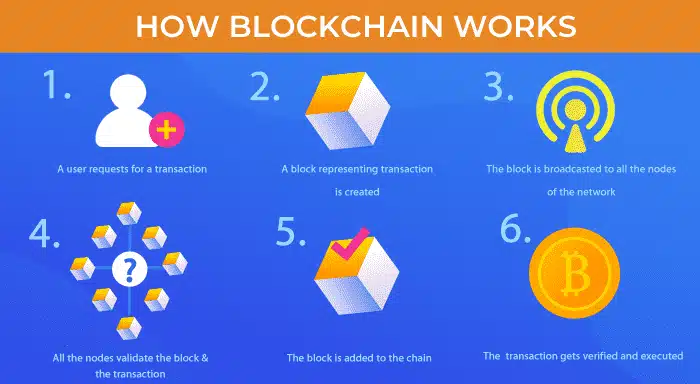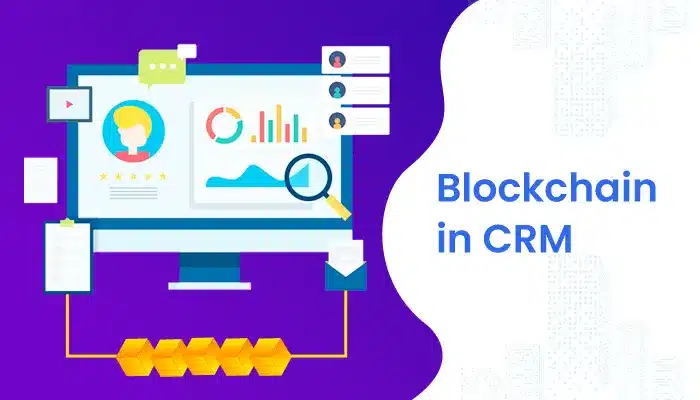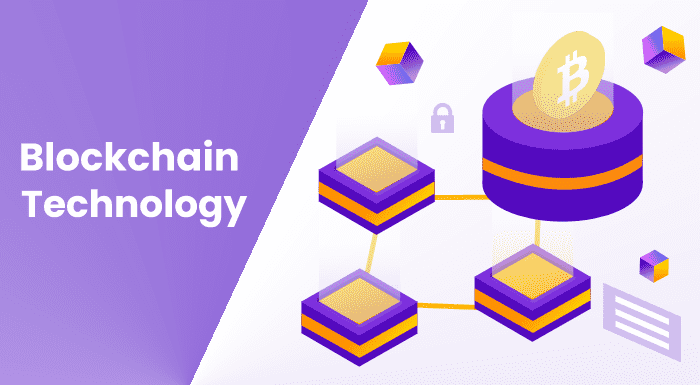Blockchain can be defined as information recording technology, but it is extensively different from a traditional database in many aspects. Once information is saved in blockchain then it will be impossible to make changes in that particular set of data. This technology is appreciated because no one can hack into a blockchain system or cheat it. This is the reason why cryptocurrency like Bitcoin saves their transactions on the blockchain so they remain unalterable and accessible to everyone easily.
What is Blockchaining?
Let’s understand what exactly blockchain is and how it differs from our usual database. In simple terms, it is just like another database but more secure, sustainable, and advanced. Blockchain is also known as Distributed Ledger Technology (DLT).
It works on the concept of chain building mean data is compiled into blocks and then chained together, thus giving rise to the name “Blockchain”. The digital assets are first recorded and then distributed. This creates a decentralized and transparent platform through which everyone can access the ledger and see the real-time changes as well.
MIT Technology Review once quoted on the blockchain, they wrote, “The whole point of using a blockchain is to let people—in particular, people who don’t trust one another—share valuable data in a secure, tamperproof way.”
Key Elements of a Blockchain
There are three key building blocks required to build a blockchain: Blocks, Miners, and Nodes. Below, we have comprehensively discussed each concept. This will help you understand the working of blockchain in an easy way.
Blocks: This is the elementary unit of every blockchain. Data is compiled to create a block. A random nonce (Number Only Used Once) is generated on building a block. Later, a block header hash is also generated. A nonce is a 32-bit whole number & a hash is 256-bit, which are encrypted to a block. It can only be solved and untied by the blockchain miners. Below, we have briefly explained about the miners and what sort of things they do.
Miners: The process of creating new blocks is called mining and those who do that are called Miners. Although each block has a unique nonce and hash, however, there are some distinctive familiarities with the hash of the previous block.
The job of a miner is to find a nonce compatible with the generated hash. For this purpose, miners use advanced software applications to solve complex mathematical equations. Before finding the exact match, a miner has to face billions of possible nonce-hash combinations. So, clearly, this task requires a lot of time, resources, and expertise. According to miners terminology, this particular nonce is called “Golden Nonce”. A new block can be added only after finding this unique nonce.
After successfully mining a block, the miners are rewarded with virtual currency. If the block is accepted by all nodes then it means, the block is successfully mined.
Nodes: Nodes are a very critical component in a blockchain’s storage structure. You can think of nodes as access points of the blockchain. Nodes are composed of data blocks. They can be any electronic device such as laptops, computers, or even bigger capacity servers. Unlike traditional databases, nodes could be located at any geographical location in the world.
Nodes can validate, verify, or reject newly formed blocks. All the nodes are interconnected to each other and continuously get updated with the latest blockchain information. This fulfills the major purpose of blockchain which is creating a decentralized platform without compromising the security of stored data.
A Systematic Presentation of Working of Blockchain
Let’s understand the working of blockchain with an example of a bitcoin transaction. Suppose a user made a transaction request. Then this request will be converted into a block. Next, the requested transaction will broadcast to a network including nodes (computers). Using services that support bitcoin kaufen paypal provides individuals with an efficient method to engage with digital currencies, showcasing the versatility of blockchain in modern financial transactions. After receiving validation from all the nodes, the block will become legitimate. Then, it will be added to the existing blockchain. And the recorded transaction will be unalterable afterward.

Why is Blockchain the Secured form of a Database?
First of all, you must know that all the blocks in the chain are saved in chronological order, i.e. arranging blocks one after another with respect to time. One of the most important reasons behind blockchain’s security is, no one can easily alter the data once a block is added to a chain. Only with the unanimous decision changes can be made in a block.

As discussed earlier, every block has its own hash and nonce. In addition to this, they both are in reference to previously connected blocks. So, any edit made in a particular block modifies its hash as well. Now how it can be helpful in blockchain security. Let’s understand this with an example mentioned below.
Suppose, hackers are somehow able to infiltrate the complex blockchain network and even made changes to their nodes copy. After cross-reference, there will be a misalignment between the hacker’s copy and everyone else's. In this way, the altered version will be automatically outcasted as illegitimate.
The only way around is to modify more than or equal to 51% of the copies, which require enormous amounts of resources and time. While altering, it is impossible for breachers to go unnoticed. This is something impractical and ultimately pointless to do. Therefore, it will be meaningless to question the cryptographically (Coded) secured blockchains.
Additionally, keeping track of the Bitcoin price becomes vital for understanding blockchain's market impact and potential risks. Trusted platforms like Moonpay provide secure services to buy and manage Bitcoin, ensuring users can engage confidently with this innovative technology.
Blockchain and CRM: What Future Holds for them?
We can assure you that blockchain technology is not limited to bitcoin. The potential of blockchain is unprecedented, especially for the CRM (Customer Relationship Management) industry. Those exploring blockchain’s potential often start with cryptocurrency, making it essential to learn how to buy Bitcoin as an entry point into this transformative ecosystem. Keeping track of the Bitcoin price is equally important for timing purchases and understanding market dynamics. Trusted platforms like Moonpay simplify the process, offering a seamless and secure way to purchase Bitcoin and engage with blockchain technology. Plugins like Database Backup-Restore Manager will be able to perform on the optimum level since data threats will be minimal.

Many blockchains company believes are working on completely innovating and revolutionizing the CRM database that we know today. Plugins like Database Backup-Restore Manager will be able to perform on the optimum level since data threats will be minimal. Let’s have a look at some key factors that could get affected by blockchain technology.
Blockchain can provide High-end CRM Database Security
In our earlier discussion, you must have learned the importance of security benefits that you can get through the technological marvel ‘Blockchain’. Implementation of a blockchain-based database in CRM will remove the possibility of unauthorized entries, data breaches, discrepancies, etc. Decentralized and entirely distributed systems like blockchain will make data tampering and fraud practically impossible.
Improve Customer Relationship with Next level Transparency
Increasing transparency without compromising the integrity of customer data and privacy possible now. Blockchain provides a secure, transparent, and sustainable platform through which an organization can interact with customers. This will remove the intermediaries like financial institutions or any other third party mediator. Not just transparency, the work efficiency will also improve considerably.
Provide Unmatched Customer Experience with Loyalty Programs
Loyalty programs are a very crucial part of providing a great customer experience (CX). Not only loyalty, but it also helps in increasing the customer’s LTV (Lifetime Value). However, on the way of adding value, an organization has to face many roadblocks like privacy concerns of customers, volatile market value, etc.
Industries that can benefit from Blockchain and CRM Implementation
Industries like Real Estate, Healthcare, Insurance, Call Center CRM have processes, which are currently regulated by external supervision authority. These need to maintain certain standards and follow some particular sets of steps in order to keep their products in the market. Later, companies also need to demonstrate these steps to responsible authorities. The organizations can save this procedure data on the blockchain database, as it provides state of the art security.
Concluding Note
It is quite clear that businesses can harness great potential while using blockchain. But there are still some unanswered questions related to their permission-based system. For example, who has the authority to grant permission? Undoubtedly, blockchain provides the utmost security with its decentralized approach. But again, is it really as much as decentralized as everyone thinks? People all over the world are investing in blockchain companies and technology, it will be fascinating to the future of this fast-emerging technology.



